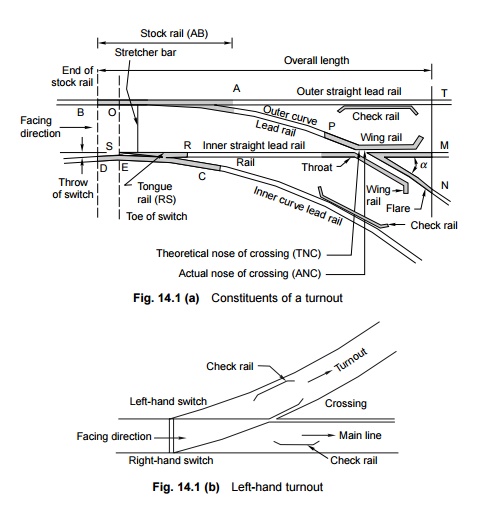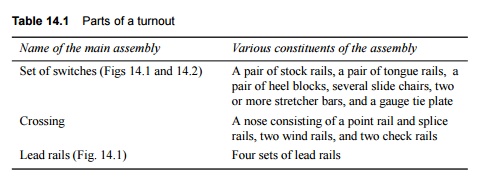Chapter: Civil : Railway Airport Harbour Engineering : Railway Engineering : Points and Crossings
Railway Engineering: Points and Crossings - Important Terms
Points and Crossings
Introduction
Points and crossings are provided
to help transfer railway vehicles from one track to another. The tracks may be
parallel to, diverging from, or converging with each other. Points and
crossings are necessary because the wheels of railway vehicles are provided
with inside flanges and, therefore, they require this special arrangement in
order to navigate their way on the rails. The points or switches aid in
diverting the vehicles and the crossings provide gaps in the rails so as to
help the flanged wheels to roll over them. A complete set of points and
crossings, along with lead rails, is called a turnout.
Important Terms
The following terms are often used in the design of points and
crossings.
Turnout It is an
arrangement of points and crossings with lead rails by means of which
the rolling stock may be diverted from one track to another. Figure 14.1(a)
shows the various constituents of a turnout. The details of these constituents
are given in Table 14.1.
Direction of a turnout A turnout
is designated as a right-hand or a left-hand turnout depending on
whether it diverts the traffic to the right or to the left. In Fig. 14.1(a),
the turnout is a right-hand turnout because it diverts as the traffic towards
the right side. Figure 14.1(b) shows a left-hand turnout. The direction of a
point (or turnout) is known as the facing direction if a vehicle
approaching the turnout or a point has to first face the thin end of the
switch. The direction is trailing direction if the vehicle has to
negotiate a switch in the trailing direction i.e., the vehicle first
negotiates the crossing and then finally traverses on the switch from its thick
end to its thin end. Therefore, when standing at the toe of a switch, if one
looks in the direction of the crossing, it is called the facing direction
and the opposite direction is called the trailing direction.
Tongue rail It is a
tapered movable rail, made of high-carbon or -manganese steel to
withstand wear. At its thicker end, it is attached to a running rail. A tongue
rail is also called a switch rail.
Stock
rail It is the running rail against which a tongue rail operates.


Points or switch A pair of
tongue and stock rails with the necessary connections and fittings forms
a switch.
Crossing A
crossing is a device introduced at the junction where two rails cross each
other to permit the wheel flange of a railway vehicle to pass from one track to
another.
Related Topics